Graham Reid | | 5 min read
Roadtrippers: 100 Smokes to Kununurra

We are about 20 miles south of coastal Cooktown in the far north of Australia when we pull off the main highway onto a side road. I glance at my map and notice a place name further down this less traveled route: The Jump Up, just past Wajul Wajul.
I have to ask.
Dean laughs.
“You'll know why when we get there. Anywhere out here where to road goes up to another level really quickly is a jump up. This one has about a one-to-three gradient.”
I'm doing the picture in my head of what that might look like – scary is my first thought – when the sealed road ends and our massive 4WD Oka hits the dusty ruts and we rattle sideway.
“Oh yeah, and of course it isn't sealed,” says Dean with a dry laugh.
Thank God we're stopping at a pub first. And not just any pub.
Remote parts of Australia have become my passion in recent years. Driving the long way between Alice Springs and Uluru – off the sealed roads and into lost canyons – and flying low over hundreds of miles of red desert where animal trails between waterholes create odd abstract patterns have been particularly memorable experiences. And usually quite solitary ones.
Despite the seeming emptiness, the desert is rich with life and seasonal changes turn dry creeks into raging deep torrents of roiling water.
And the Far North of Queensland (the pointy bit up to Cape York known as York Peninsula) where we are traveling now in the sturdy Oka – a region almost three quarters the area of Britain with cattle stations the size of Belgium – is yet another eye-opener.
Standing at the remote tip where a sign in the rocks proclaims we are the most northern point of the Australian continent I ask Dean Nulty, guide and driver to our group of five, where the nearest traffic lights might be.
About 650 miles, unless you turn right about halfway down the Peninsula and head to the bauxite town of Weipa on the west coast.
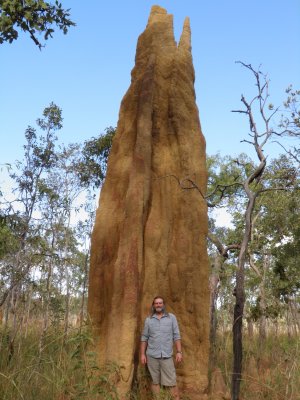 This is a vast country and you can
drive a long way without seeing another car or people once you leave
the small settlements.
This is a vast country and you can
drive a long way without seeing another car or people once you leave
the small settlements.
You do however see a lot of termite towers – we haul over to photograph one that stands 30 feet high – and every now and again a kangaroo, ostrich, wallaby, dingo, strange bird and, near rivers and inlets, enormous crocodiles.
We're advised not to walk along riverbanks or too close to the edge of deep creeks. We don't.
Out there the landscape constantly changes and there are 22 different kinds of tropical savannah, dense rainforest near the coast further south, and areas of vast flat dry desert.
Near the Archer River Roadhouse, a crude hand-painted sign by the muddy creek nailed up a tree which reads “We were here in a boat 14th March 2003”.
The river had risen 48 feet, and that's why they call it “the Wet Season”.
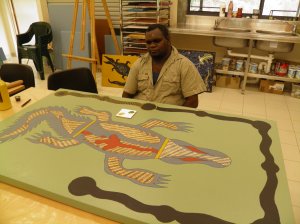
We have seen their rock art which dates back thousands of years and looked at petroglyphs which are even more ancient.
And of course we have stopped at pubs.
“This is it,” says Dean as the Oka grinds to a dusty halt beside the famous Lion's Den (established 1875), our last stop before hitting The Jump Up.
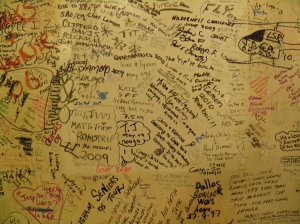
Every inch of every wall is covered in graffiti, signatures, scribbles, obscenities and slogans in support of various sports teams.
Even around the sign which says you shouldn't write on the walls without permission. Someone is pretty liberal with “permission”. The ceiling has ragged shirts and baseball caps hanging from it, the bar ablaze with bumper stickers, beer labels and photos.
We shoot pool, have a beer, and read the walls. Dean, we note with relief, is staying off the cold stuff. The Jump Up looms.
Later we hit the rugged road again, stop at Wajul Wajul (which means “waterfall waterfall” in the local Aboriginal dialect) where some local artists are at work on elaborate paintings, and then cross a river where there is fresh water on one side of the small bridge and salt on the other.
And then we hit The Jump Up.
Our vehicle crashes down though the gears and we creep up at fewer than 5mph. The Oka groans as Dean seems to find every rut in the road, there is an odd stretch of concrete over the steepest part (“That wasn't here before,” says Dean with cheerful relief) and after 20 minutes we are at the top.
We get out and breath the warm air, gulp water and check the ground for snakes.
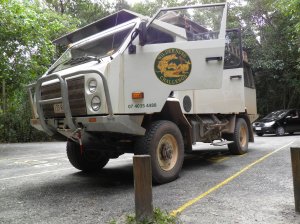
I say the next bit should be easy, it's all downhill on the map.
“Yeah,” says Dean and points back down The Jump Up where the ruts are a foot deep and this area known as The Bloomfield Track – just broken lines on my map – has earned that underselling description.
“Downhill all right, and pretty much like that all the way.”
We get back in the Oka, strap on the seatbelts and hold on. Real tight.
For more on Australia's Far North start here.
Wilderness Challenge offer a range
of 4WD adventure safaris of various durations (7 to 16-day tours)
across northern Australia. These include camping options,
accommodated safaris and group tours through the Kimberley, Kakadu,
Gulf Savannah and Cape York Peninsula regions. Tours carry a maximum
of 13 passengers.
For more information visit: www.wilderness-challenge.com.au

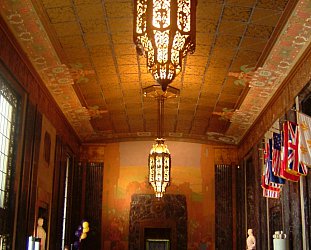
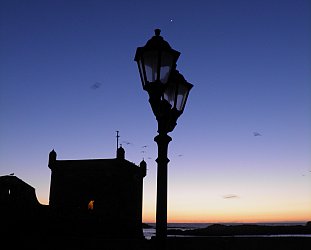
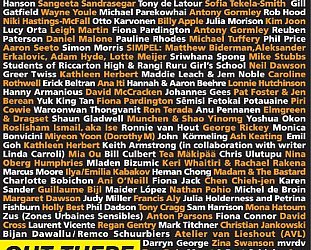
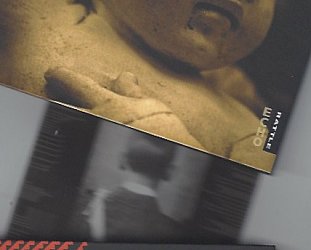
post a comment